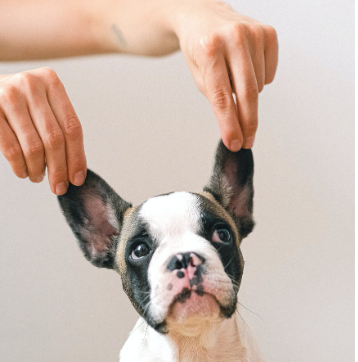Clubs Offering:

Strolling with a happy, tail-wagging companion securely by our sides is one of life’s greatest joys. We love our furry, four-legged friends. While dogs are America’s most beloved pet, humans have bred and domesticated dogs for thousands of years for important work functions. Modern day working dog are employed in tasks ranging from drug and explosive detection, agriculture, tracking, emergency recovery, mental health treatment, and much more. Service dogs are working partners for people with disabilities. Hearing dogs are specifically trained to support the needs of severely hearing impaired people. They serve as their masters’ ears and provide the added benefit of companionship. By federal law, service animals including hearing dogs may go anywhere the public is permitted (restaurants, stores, government buildings, etc.) and live in housing where pets are prohibited. They are not pets–but valuable assistants for people with disabilities.
Hearing dogs are trained to alert their owners to common sounds like doorbells, oven timers, smoke alarms, telephones, babies’ cries, or alarm clocks. Hearing dogs make physical contact with their masters, nudging or pawing them to get their attention. Most are trained to lead their handlers toward the source of a sound.
Outside the home, hearing dogs perform additional duties. Most will not respond to ambient street noises like car horns or sirens. However, because they are keenly alert to environmental sounds, their partners can ascertain a great deal of information about their surroundings by observing the dogs’ cues. This serves to alert people with severe hearing losses to the approach of persons or vehicles which may be a threat or hazard. Owners of hearing dogs report that having a trained canine helper gives them an increased sense of security and independence that other assistive means just can’t provide.
After the Hearing Dog in Training has a thorough understanding of the individual pieces of the alert behaviors, the trainer links the alert behaviors to the imprinted sounds, one by one. Eventually, each individual sound acts as a cue that triggers the alert. The cues (sounds) all differ, but the end behavior (alert) remains the same.
With time and training, Hearing Dogs can grow their “sound vocabulary” to dozens of sounds. Don’t move too quickly. Take the time to introduce new sounds slowly and thoroughly, and to individually link them to the alert behavior. Spending time on these foundation skills provides you with an excellent platform from which to train the remaining, and more complex, pieces of the alert behavior chain.
Hide and seek and other games are common at this level of training. They encourage the dog to get creative about problem solving and decision making. The games also build the young dog’s frustration tolerance and ability to “shape,” or puzzle through increasingly complex behaviors with the trainer’s guidance.
Once you’ve built an enthusiastic nose target, you’re either done with the first part of the alert, or you’re just getting started. If you want a behavior other than a nose target to your closed hand, like a nose bump to your leg, a paw touch or a shoulder bump, you can easily shape it bit by bit. Gradually requiring your dog to make microsteps towards the finished behavior, and reward each tiny step of progress.
By now, you know there are two major pieces to a Hearing Dog’s soundwork: the environmental cue and the following cascade of alert behaviors. The environmental cue consists of each individual sound the dog knows. The trainer introduces every sound to the dog, one by one, and gives the sound significance. This process is known as “imprinting.” By imprinting the sound, the dog learns that some sounds matter more than other sounds. The dog quickly learns to pay attention to the imprinted sounds, because they carry significance and yummy things usually follow them.
Hearing Dogs – What Do You Need to Know About Them?

Everyday life can be not only challenging but also dangerous for people with disabilities, especially when they are unable to see or hear their surroundings. Sometimes staying at home and being unable to understand what is going on due to physical or mental disorders can be as dangerous as going outside. Many people decide to rely on service dogs in order to get provided with emotional or physical support.
In this article, we will get a closer look at the assistance that hearing dogs provide to individuals with hearing impairments.
First, we would like to explain what the term “Hearing Dogs” means.
What My Hearing Service Dog Alerts Me To | Hearing Lauren
Dogs are highly valued for their ability to hear sounds that we as humans cannot hear. They can also more easily differentiate between sounds, making them great service dogs for deaf people, where they alert us to sounds relevant to our safety and survival.
Smudge was my first hearing dog, and he has helped me go from social isolation to happily deliver lectures in front of hundreds of people. Smudge passed away in 2012 and Bailey is my assistance dog now. Bailey has a huge personality and charms everyone we meet by wrapping his white furry paws around their legs and giving them cuddles.
Over the last 20 years, more and more dogs have been trained for the purpose of improving deaf people’s lives. People with profound hearing loss benefit most from having a hearing dog because they encourage other people to come up and talk to you, breaking the ice and communication barrier, giving you more confidence.
If you’re deaf and thinking about adopting a hearing dog or know someone who is deaf and might benefit from having a service dog, this article is for you.